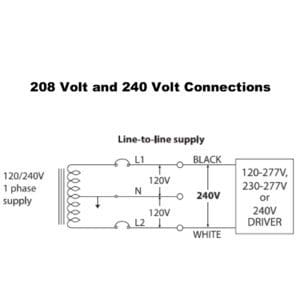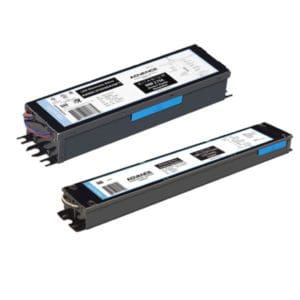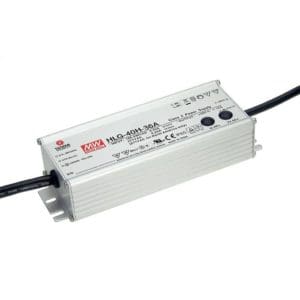
277V Lighting Wiring Diagram: How to Wire a 120v-277v LED Driver to 208v Line
It all sounded like a bad joke. Two Texas electricians walk into a bar arguing if a 120v-277v LED driver would work on a 208v line, considering the complexities of electrical wiring. To solve the issue, they called an Access Fixtures lighting specialist. LED lighting has become the default choice to illuminate commercial, industrial, hospitality, and sports venues. Still, there are lots of questions about LED lighting. For optimal viewing of the wiring diagrams and other resources on the site, it is important to use an updated browser. Information on the 277v lighting wiring diagram can be found below.
Will a 120v-277v LED driver in an LED high bay luminaires work on 208-volt power supplies?
Key Takeaways
-
- Versatile Voltage Range: 120-277v LED drivers automatically adjust to any voltage within this range, including 208v, simplifying installations.
- Clear Wiring: In a 120-277 volt light fixture wiring diagram, black, white, green, grey, and purple wires serve specific purposes, especially for 0-10v dimming.
- Time-Saving Solution: Using 120-277v drivers eliminates the need to know the exact voltage beforehand, streamlining the installation process.
Understanding the Wiring Diagram
A wiring diagram is a crucial tool for anyone working with electrical systems, as it visually represents the electrical connections within a circuit or system. These diagrams are essential for troubleshooting, repairing, and ensuring that installations are done correctly and safely. Typically, a wiring diagram includes symbols and labels that denote various components such as wires, switches, and outlets.
When reading a wiring diagram, it’s important to familiarize yourself with the symbols and labels used. The diagram should be clear and easy to interpret, with each component distinctly labeled. It should also illustrate the connections between components, including the wires and any other necessary connections.
For a 208v lighting fixture, the wiring diagram will generally show three wires: the hot wire, neutral wire, and safety ground wire. The hot wire is usually connected to the L1 terminal, the neutral wire to the L2 terminal, and the safety ground wire to the grounding terminal. Understanding these connections is vital for ensuring a safe and effective installation.
Will a 120v-277v LED Driver Work on a 208v Line?
In this case and pretty much every case, the answer is yes. The 120v-277v driver will work even if it is in a canopy light, a wall pack, or an area light. Just like fluorescent ballasts marked 120v-277v, if an LED driver is marked 120v-277v, it will self-adjust to the voltage of the power supply being supplied assuming the voltage falls between 120v and 277v range. Understanding these voltage levels is crucial for proper installations in both residential and commercial settings.
The confusion on this matter comes from older products like HID ballasts. One popular option for HID ballasts used in pulse start metal halide fixtures quad tap. A quad tap ballast would be marked 120v, 208v, 240v, 277v and would have to be set up for the correct line voltage. LED drivers and fluorescent ballasts marked with a dash between the voltage will function in that range. For example, 120v-277v will operate on any voltage between 120v and 240v.

120v-277v Driver Works on a 208v Line
The driver in the photo is from a LED bollard light and is marked INPUT 100-240VAC and 277VAC, making it compatible with various electrical systems. This means the driver will work on any voltage between 100 volts and 240 volts as well as 277 volts. It would not work on voltage between 241 volts and 276 volts. To find additional information on any LED driver, you can simply Google the manufacturer’s name and the model number. For example, here is a link to the series of Meanwell LED drivers like the one above. It is important to keep this information up to date to ensure compatibility with the latest electrical systems.
This wide voltage compatibility makes the 120v-277v driver versatile for various applications, ensuring consistent performance across different power supplies. It simplifies installation and reduces errors, as the driver automatically adjusts to the available voltage, making it ideal for projects in locations with varying electrical systems.

It’s a Black and White and Green and Grey and Purple World
If your LED fixture is ready for 0-10v dimming, it will have 5 wires with specific color coding: black, white, green, grey, and purple. Each wire has a specific purpose.
- Black and White – Power
- Green – Ground
- Purple and Grey – Low voltage diming
Black, white and green are expected. Since all Access Fixtures luminaires should be installed by a licensed electrician, as a licensed electrician this would be obvious to you. Less obvious is the green and grey wire. These are frequently in a separated wire exiting the fixture or the LED driver. If you are not using 0-10v dimming, make sure the green and grey are separately capped and secured out of the way. If you are using 0-10v low voltage diming, then connect them to the low voltage diming circuit. For more information about 0-10v dimming, click here.
120v-277v LED Drivers Are a Benefit and Time Saver
LED drivers are a benefit and time saver, simplifying the installation process as an electrical contractor can quote a job without knowing the exact voltage. For instance, the other day, another electrical contractor called up specifically looking for bollard lights with a 120v-277v driver because he had no idea what voltage was being used. If he showed up with LED bollard lights that employed a 120v-277v driver, he would be able to install the bollard lights on any voltage between 120v and 277v.
Additionally, these drivers eliminate the need to carry multiple fixtures for different voltage ranges, as one fixture can handle a wide range of inputs. This flexibility not only saves time during installation but also streamlines inventory management, allowing contractors to handle various jobs with fewer fixture types. By reducing the need for voltage-specific drivers, electricians can minimize installation delays, avoid errors, and ensure a smooth, efficient workflow.

Installation and Troubleshooting
Wiring a 208v Lighting Fixture
Wiring a 208v lighting fixture requires precision and a solid understanding of the wiring diagram. Typically, a 208v lighting fixture consists of three wires: one hot, one neutral, and one safety ground. The hot wire is usually connected to the L1 terminal, while the neutral wire is connected to the L2 terminal. The safety ground wire is connected to the grounding terminal.
When wiring a 208v lighting fixture, it’s crucial to ensure that the voltage rating of the fixture matches the voltage supply. A 208v lighting fixture can be wired to a 208v single-phase circuit, which consists of two hot wires and one neutral wire. The voltage between the two hot wires is 208v, and the voltage between each hot wire and the neutral wire is 120v.
To wire a 208v lighting fixture, follow these steps:
- Turn off the power to the circuit at the main electrical panel.
- Verify the voltage rating of the fixture and the voltage supply.
- Connect the hot wire to the L1 terminal and the neutral wire to the L2 terminal.
- Connect the safety ground wire to the grounding terminal.
- Turn on the power to the circuit and test the fixture.
By following these steps and referring to the wiring diagram, you can ensure a proper and safe connection for your 208v lighting fixture.
Troubleshooting Common Issues
Troubleshooting common issues with 208v lighting fixtures requires a systematic approach. Here are some common issues and their solutions:
- No power to the fixture: First, check the voltage supply and ensure that the power is turned on at the main electrical panel. Verify that the wiring connections are secure and not loose.
- Fixture not turning on: Refer to the wiring diagram and ensure that the hot wire is connected to the L1 terminal and the neutral wire is connected to the L2 terminal. Also, verify that the safety ground wire is connected to the grounding terminal.
- Fixture flickering: Check the voltage supply to ensure it’s stable. Loose wiring connections can also cause flickering, so make sure all connections are secure.
By addressing these common issues with a methodical approach, you can quickly identify and resolve problems with your 208v lighting fixtures.
Additional Considerations for 208v Lighting
When dealing with 208v lighting fixtures, there are several additional considerations to keep in mind to ensure a successful installation. First and foremost, it’s crucial to verify that the fixture is properly wired and installed. This involves making sure that the hot wire, neutral wire, and safety ground wire are connected correctly and that the fixture is adequately grounded.
Another important factor is the voltage and current requirements of the fixture. A 208v lighting fixture needs a specific voltage and current to function correctly. Exceeding these requirements can lead to damage or pose a safety hazard. Always check the manufacturer’s specifications to ensure compliance.
Safety precautions are paramount when working with electrical systems. Always turn off the power to the circuit before beginning any work. Use personal protective equipment (PPE) such as gloves and safety glasses, and follow proper lockout/tagout procedures to prevent accidental energization of the circuit.
Verification and Safety Precautions
Verification and safety precautions are crucial when working with electrical systems. Here are some essential safety precautions to follow:
- Verify the voltage rating: Ensure that the voltage rating of the fixture matches the voltage supply.
- Turn off the power: Always turn off the power to the circuit at the main electrical panel before starting any work.
- Use personal protective equipment: Wear personal protective equipment, such as gloves and safety glasses, when working with electrical systems.
- Follow the wiring diagram: Carefully follow the wiring diagram to ensure that all connections are made correctly.
- Test the fixture: After installation, test the fixture to ensure it’s working correctly.
By following these safety precautions and verification procedures, you can ensure a safe and successful installation of your 208v lighting fixture. Always prioritize safety and accuracy to prevent any electrical hazards.
Conclusion
Understanding the intricacies of a 120-277 volt light fixture wiring diagram can simplify the installation process and ensure your lighting system functions efficiently. Whether working with 120v, 208v, or any voltage within the 120v-277v range, modern LED drivers are designed to self-adjust, making them highly versatile and easy to work with. By following the wiring diagram, knowing the function of each wire, and ensuring proper setup, electricians can save time and avoid complications. If you have any further questions about wiring or lighting solutions, consulting with a lighting specialist can provide the support and expertise you need for successful installations.
120 277 Volt Light Fixture Wiring Diagram Frequently Asked Questions (FAQs)
You have questions on 120-277 Volt Lighting Fixture Wiring Diagram. We have answers. If you have a question that isn’t answered below, contact an Access Fixtures lighting specialist at (800) 468-9925 or click here.
Will a 120v-277v LED driver work on a 208v power supply?
Yes, a 120v-277v LED driver will function on a 208v line, as it can automatically adjust to any voltage within the 120v to 277v range, making wiring easier for electricians.
What is the purpose of the black, white, green, grey, and purple wires in a 120-277 volt light fixture wiring diagram?
In a typical 120-277 volt light fixture wiring diagram, black and white wires provide power, the green wire is for grounding, and the grey and purple wires are used for 0-10v dimming.
Can I install a 120v-277v LED driver on any voltage between 120v and 277v?
Yes, 120-277v LED drivers are designed to function on any voltage within that range, simplifying the wiring process as shown in a 120-277 volt light fixture wiring diagram.
Why do HID ballasts require different setup compared to 120v-277v LED drivers?
Unlike 120-277v LED drivers, HID ballasts require manual setup for specific voltage, making them more complicated than the modern 120-277 volt light fixture wiring diagram process.
Do I need to cap the grey and purple wires if I’m not using dimming?
Yes, if you’re not using 0-10v dimming, the grey and purple wires should be capped and secured, as indicated in a 120-277 volt light fixture wiring diagram.
How does a 120v-277v driver save time for electricians?
A 120-277v driver eliminates the need to know the exact voltage beforehand, allowing for easier installation and less preparation time based on a simple 120-277 volt light fixture wiring diagram.
What should I do if my LED fixture has 5 wires and I am unsure of their function?
Consult the 120-277 volt light fixture wiring diagram. Typically, black and white are for power, green is for grounding, and grey and purple are for dimming.
Can I use a 120v-277v driver on a voltage supply between 241v and 276v?
No, based on a 120-277 volt fixture wiring diagram, the driver will not work on voltages between 241v and 276v. It functions within the 100v-240v and 277v ranges.
How do I find more information about the LED driver in my fixture?
To better understand your LED driver, consult the manufacturer’s information or search for the model online, ensuring it aligns with your 120-277 volt light fixture wiring diagram.
Who should I contact if I have technical questions about lighting?
If you have specific questions about your 120-277 volt wiring diagram, contact an Access Fixtures lighting specialist for expert guidance.
Speak with an Access Fixtures Lighting Specialist
Access Fixtures lighting specialists don’t know how to wire a panel or how to run a power supply to a luminaire, but they do know lighting. If you are an electrician with a technical question about lighting or want to know the best light fixture to select for your client’s upcoming project, the lighting specialists at Access Fixtures are here to help you win more jobs and make more money. Call us at (800) 468-9925.
Conclusion and Next Steps
In conclusion, wiring a 208v lighting fixture demands meticulous attention to detail and a solid understanding of electrical systems. By adhering to the proper procedures and taking necessary safety precautions, you can ensure that the fixture is installed both correctly and safely.
If you are uncertain about any aspect of the installation, it is always advisable to consult a licensed electrician or seek additional guidance. Additionally, make sure to follow all local and national electrical codes and regulations, and obtain any necessary permits or inspections before completing the installation.
By following these steps and prioritizing safety, you can ensure that your 208v lighting fixture is installed correctly and provides reliable and efficient lighting for your needs.
